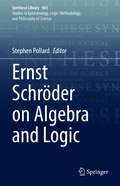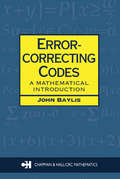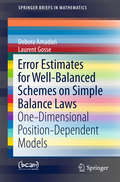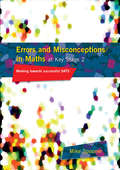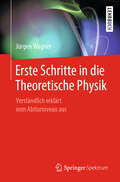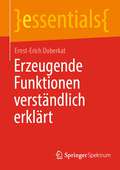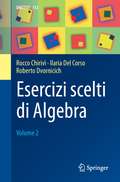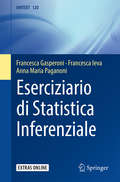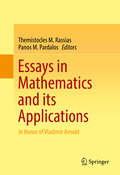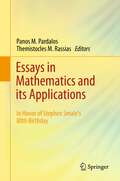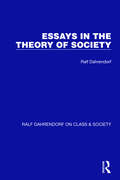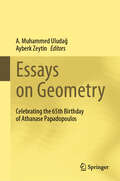- Table View
- List View
Erlebnisse an Grenzen - Grenzerlebnisse mit der Mathematik
by Bert-Wolfgang SchulzeDie innerdeutsche Grenze verlief nicht nur zwischen zwei Staaten, sondern spiegelte sich sogar in den Grundlagenwissenschaften wie der Mathematik wider. Aus persönlicher Sicht zeigt der Autor den subjektiven Umgang mit Erzeugung, Bewertung und Propagierung wissenschaftlicher Resultate in den zwei unterschiedlichen Gesellschaftssystemen. Auf unterhaltsame Art werden Innensichten aus Forschungsinstitutionen, der Wissenschaftsförderung und die verschiedenen Einstellungen zur Zweckbestimmung reiner und angewandter Forschung dargelegt.
Ernst Schröder on Algebra and Logic (Synthese Library #465)
by Stephen PollardThis volume offers English translations of three early works by Ernst Schröder (1841-1902), a mathematician and logician whose philosophical ruminations and pathbreaking contributions to algebraic logic attracted the admiration and ire of figures such as Dedekind, Frege, Husserl, and C. S. Peirce. Today he still engages the sympathetic interest of logicians and philosophers. The works translated record Schröder’s journey out of algebra into algebraic logic and document his transformation of George Boole’s opaque and unwieldy logical calculus into what we now recognize as Boolean algebra. Readers interested in algebraic logic and abstract algebra can look forward to a tour of the early history of those fields with a guide who was exceptionally thorough, unfailingly honest, and deeply reflective.
Error Correcting Codes: A Mathematical Introduction
by D J. BaylisAssuming little previous mathematical knowledge, Error Correcting Codes provides a sound introduction to key areas of the subject. Topics have been chosen for their importance and practical significance, which Baylis demonstrates in a rigorous but gentle mathematical style.Coverage includes optimal codes; linear and non-linear codes; general techniques of decoding errors and erasures; error detection; syndrome decoding, and much more. Error Correcting Codes contains not only straight maths, but also exercises on more investigational problem solving. Chapters on number theory and polynomial algebra are included to support linear codes and cyclic codes, and an extensive reminder of relevant topics in linear algebra is given. Exercises are placed within the main body of the text to encourage active participation by the reader, with comprehensive solutions provided.Error Correcting Codes will appeal to undergraduate students in pure and applied mathematical fields, software engineering, communications engineering, computer science and information technology, and to organizations with substantial research and development in those areas.
Error Estimates for Well-Balanced Schemes on Simple Balance Laws
by Debora Amadori Laurent GosseThis monograph presents, in an attractive and self-contained form, techniques based on the L1 stability theory derived at the end of the 1990s by A. Bressan, T. -P. Liu and T. Yang that yield original error estimates for so-called well-balanced numerical schemes solving 1D hyperbolic systems of balance laws. Rigorous error estimates are presented for both scalar balance laws and a position-dependent relaxation system, in inertial approximation. Such estimates shed light on why those algorithms based on source terms handled like "local scatterers" can outperform other, more standard, numerical schemes. Two-dimensional Riemann problems for the linear wave equation are also solved, with discussion of the issues raised relating to the treatment of 2D balance laws. All of the material provided in this book is highly relevant for the understanding of well-balanced schemes and will contribute to future improvements.
Errors and Misconceptions in Maths at Key Stage 2: Working Towards Success in SATS
by Mike SpoonerThe activities in this book are designed both to help children to learn and to understand math concepts, and also to prepare them for taking SATS papers at KS2. There is plenty of research evidence to suggest that children are helped in their understanding of math problems if teachers focus on common misconceptions, and if children are given opportunities for discussion and explanation of their own understanding. Children can also feel stigmatized by being made to focus on their own errors. Mike Spooner has developed activities that present already completed work which children then assess, correct and discuss - in this way they can analyze mistakes without damage to their own self-esteem. The activities are presented in the same format as the SATS papers, to give children practice in coping with that format. The book also contains writing frames that children can use to structure their discussions of math problems.
Errors in Medical Science Investigations
by Hamid SooriThis book introduces all common errors in medical science fields and the ways to control them. Systematic errors could be controlled both during study design and statistical analysis. Some errors have been presented in small segments but not in a comprehensive book. It covers many common errors that usually affect the research proposals, final reports, theses, and scientific presentations in the field of medical sciences as well as the rejection reasons on scientific papers. It will help researchers to control common errors using epidemiological and statistical methods.
Errors, Blunders, and Lies: How to Tell the Difference (ASA-CRC Series on Statistical Reasoning in Science and Society)
by David S. SalsburgWe live in a world that is not quite "right." The central tenet of statistical inquiry is that Observation = Truth + Error because even the most careful of scientific investigations have always been bedeviled by uncertainty. Our attempts to measure things are plagued with small errors. Our attempts to understand our world are blocked by blunders. And, unfortunately, in some cases, people have been known to lie. In this long-awaited follow-up to his well-regarded bestseller, The Lady Tasting Tea, David Salsburg opens a door to the amazing widespread use of statistical methods by looking at historical examples of errors, blunders and lies from areas as diverse as archeology, law, economics, medicine, psychology, sociology, Biblical studies, history, and war-time espionage. In doing so, he shows how, upon closer statistical investigation, errors and blunders often lead to useful information. And how statistical methods have been used to uncover falsified data. Beginning with Edmund Halley’s examination of the Transit of Venus and ending with a discussion of how many tanks Rommel had during the Second World War, the author invites the reader to come along on this easily accessible and fascinating journey of how to identify the nature of errors, minimize the effects of blunders, and figure out who the liars are.
Errors-in-Variables Methods in System Identification (Communications and Control Engineering)
by Torsten SöderströmThis book presents an overview of the different errors-in-variables (EIV) methods that can be used for system identification. Readers will explore the properties of an EIV problem. Such problems play an important role when the purpose is the determination of the physical laws that describe the process, rather than the prediction or control of its future behaviour. EIV problems typically occur when the purpose of the modelling is to get physical insight into a process. Identifiability of the model parameters for EIV problems is a non-trivial issue, and sufficient conditions for identifiability are given. The author covers various modelling aspects which, taken together, can find a solution, including the characterization of noise properties, extension to multivariable systems, and continuous-time models. The book finds solutions that are constituted of methods that are compatible with a set of noisy data, which traditional approaches to solutions, such as (total) least squares, do not find. A number of identification methods for the EIV problem are presented. Each method is accompanied with a detailed analysis based on statistical theory, and the relationship between the different methods is explained. A multitude of methods are covered, including: instrumental variables methods; methods based on bias-compensation; covariance matching methods; and prediction error and maximum-likelihood methods. The book shows how many of the methods can be applied in either the time or the frequency domain and provides special methods adapted to the case of periodic excitation. It concludes with a chapter specifically devoted to practical aspects and user perspectives that will facilitate the transfer of the theoretical material to application in real systems. Errors-in-Variables Methods in System Identification gives readers the possibility of recovering true system dynamics from noisy measurements, while solving over-determined systems of equations, making it suitable for statisticians and mathematicians alike. The book also acts as a reference for researchers and computer engineers because of its detailed exploration of EIV problems.
Erste Schritte in die Theoretische Physik: Verständlich erklärt vom Abiturniveau aus
by Jürgen WagnerDieses Lehrbuch bietet einen einfachen Zugang zur Theoretischen Physik und realisiert einen durchgängigen Anschluss an die in der Schule erworbenen physikalisch-mathematischen Vorkenntnisse. Aus seiner Erfahrung als Diplomlehrer für Physik und Mathematik heraus ebnet der Autor den Weg in die Theoretische Physik. Er stützt sich dabei auf die folgenden Prinzipien: Viele Abbildungen und detailliert vorgerechnete Beispiele tragen wesentlich zum Verständnis der Darstellungen bei. Verwendete „Rechentricks“ werden angegeben und erläutert.Die erforderliche Mathematik wird schrittweise und ausführlich erarbeitet.Die Struktur des Lehrbuchs orientiert sich an folgenden zentralen Phänomenen und Grundbegriffen: Bewegung, Elektrizität und Magnetismus, Relativität sowie Quanten. In diesem Rahmen werden die üblichen Inhalte der Module Theoretische Mechanik, Elektrodynamik, Relativitätstheorie und Quantenmechanik verortet.Die experimentelle Basis für theoretische Ansätze wird explizit benannt, um die Besonderheiten der naturwissenschaftlichen Methode zu betonen, die sich von Autoritätsgläubigkeit sowie Spekulation deutlich abgrenzt.Auf bestehende Interpretationsprobleme der Quantenmechanik wird ausdrücklich hingewiesen. Begriffe wie „Welle-Teilchen-Dualismus“ oder „Kollaps der Wellenfunktion“ werden vermieden, da sie Missverständnisse provozieren können.Dieses Buch richtet sich an Studierende der Natur- und Ingenieurwissenschaften sowie des Lehramts, zu deren Studieninhalten mindestens ein Modul Theoretische Physik gehört. Es wendet sich auch an alle, die sich für Fragestellungen der Naturwissenschaften oder Naturphilosophie interessieren und über eine positive Einstellung zur Mathematik verfügen.
Erste Schritte in die Theoretische Physik: Verständlich erklärt vom Abiturniveau aus
by Jürgen WagnerDieses Lehrbuch bietet einen einfachen Zugang zur Theoretischen Physik und realisiert einen durchgängigen Anschluss an die in der Schule erworbenen physikalisch-mathematischen Vorkenntnisse. Aus seiner Erfahrung als Diplomlehrer für Physik und Mathematik heraus ebnet der Autor den Weg in die Theoretische Physik. Er stützt sich dabei auf die folgenden Prinzipien: Viele Abbildungen und detailliert vorgerechnete Beispiele tragen wesentlich zum Verständnis der Darstellungen bei. Verwendete „Rechentricks“ werden angegeben und erläutert.Die erforderliche Mathematik wird schrittweise und ausführlich erarbeitet.Die Struktur des Lehrbuchs orientiert sich an folgenden zentralen Phänomenen und Grundbegriffen: Bewegung, Elektrizität und Magnetismus, Relativität sowie Quanten. In diesem Rahmen werden die üblichen Inhalte der Module Theoretische Mechanik, Elektrodynamik, Relativitätstheorie und Quantenmechanik verortet.Die experimentelle Basis für theoretische Ansätze wird explizit benannt, um die Besonderheiten der naturwissenschaftlichen Methode zu betonen, die sich von Autoritätsgläubigkeit sowie Spekulation deutlich abgrenzt.Auf bestehende Interpretationsprobleme der Quantenmechanik wird ausdrücklich hingewiesen. Begriffe wie „Welle-Teilchen-Dualismus“ oder „Kollaps der Wellenfunktion“ werden vermieden, da sie Missverständnisse provozieren können.Dieses Buch richtet sich an Studierende der Natur- und Ingenieurwissenschaften sowie des Lehramts, zu deren Studieninhalten mindestens ein Modul Theoretische Physik gehört. Es wendet sich auch an alle, die sich für Fragestellungen der Naturwissenschaften oder Naturphilosophie interessieren und über eine positive Einstellung zur Mathematik verfügen.Die vorliegende zweite Auflage wurde um ein Kapitel zum Phänomen Wärme mit Inhalten aus der klassischen und statistischen Thermodynamik erweitert sowie an zahlreichen Stellen ergänzt und verbessert.
Erzeugende Funktionen verständlich erklärt (essentials)
by Ernst-Erich DoberkatErzeugende Funktionen sind ein wichtiges Werkzeug in der Kombinatorik und der Theoretischen Informatik. Das Buch zeigt an vielen Beispielen, wie man dieses Werkzeug verwendet, mit dem eine Folge reeller Zahlen durch eine einzige Funktion repräsentiert wird. Es wird eine Einführung in die Technik der Gewinnung und der Manipulation erzeugender Funktionen gegeben; wichtige Folgen und ihre korrespondierenden Funktionen werden behandelt.
Escape from Model Land: How Mathematical Models Can Lead Us Astray and What We Can Do About It
by Erica ThompsonHow do mathematical models shape our world - and how can we harness their power for good?Models are at the centre of everything we do. Whether we use them or are simply affected by them, they act as metaphors that help us better understand the increasingly complex problems facing us in the modern world. Without models, we couldn't begin to tackle three of the major challenges facing modern society: regulation of the economy, climate change and the COVID-19 pandemic. Yet in recent years, the validity of the models we use has been hotly debated and there has been renewed awareness of the disastrous consequences when the makers and interpreters of models get things wrong.Drawing on contemporary examples from finance, climate and health policy, Erica Thompson explores what models are, why we need them, how they work and what happens when they go wrong. This is not an audiobook that argues we should do away with models, but rather, that we need to properly understand how they are constructed - and how some of the assumptions that underlie the models we use can have significant unintended consequences. Unexpectedly humorous, thought-provoking and passionate, this is essential listening for everyone.(P) 2022 Hodder & Stoughton Limited
Escape from Model Land: How Mathematical Models Can Lead Us Astray and What We Can Do About It
by Erica Thompson'A brilliant account of how models are so often abused and of how they should be used' John KayHow do mathematical models shape our world - and how can we harness their power for good?Models are at the centre of everything we do. Whether we use them or are simply affected by them, they act as metaphors that help us better understand the increasingly complex problems facing us in the modern world. Without models, we couldn't begin to tackle three of the major challenges facing modern society: regulation of the economy, climate change and the COVID-19 pandemic. Yet in recent years, the validity of the models we use has been hotly debated and there has been renewed awareness of the disastrous consequences when the makers and interpreters of models get things wrong.Drawing on contemporary examples from finance, climate and health policy, Erica Thompson explores what models are, why we need them, how they work and what happens when they go wrong. This is not a book that argues we should do away with models, but rather, that we need to properly understand how they are constructed - and how some of the assumptions that underlie the models we use can have significant unintended consequences. Unexpectedly humorous, thought-provoking and passionate, this is essential reading for everyone.
Escape from Model Land: How Mathematical Models Can Lead Us Astray and What We Can Do About It
by Erica ThompsonWhy mathematical models are so often wrong, and how we can make better decisions by accepting their limits Whether we are worried about the spread of COVID-19 or making a corporate budget, we depend on mathematical models to help us understand the world around us every day. But models aren&’t a mirror of reality. In fact, they are fantasies, where everything works out perfectly, every time. And relying on them too heavily can hurt us. In Escape from Model Land, statistician Erica Thompson illuminates the hidden dangers of models. She demonstrates how models reflect the biases, perspectives, and expectations of their creators. Thompson shows us why understanding the limits of models is vital to using them well. A deeper meditation on the role of mathematics, this is an essential book for helping us avoid either confusing the map with the territory or throwing away the map completely, instead pointing to more nuanced ways to Escape from Model Land.
Escape from Shadow Physics: The Quest to End the Dark Ages of Quantum Theory
by Adam Forrest KayThis "artfully written...splendid history of classical and quantum physics" (Science) that "rightfully highlights the limitations of current physics" (Wall Street Journal) and argues for a revolutionary new understanding of quantum mechanics The received wisdom in quantum physics is that, at the deepest levels of reality, there are no actual causes for atomic events. This idea led to the outlandish belief that quantum objects—indeed, reality itself—aren&’t real unless shaped by human measurement. Einstein mocked this idea, asking whether his bed spread out across his room unless he looked at it. And yet it remains one of the most influential ideas in science and our culture. In Escape from Shadow Physics, Adam Forrest Kay takes up Einstein&’s torch: reality isn&’t mysterious or dependent on human measurement, but predictable and independent of us. At the heart of his argument is groundbreaking research with little drops of oil. These droplets behave as particles do in the long-overlooked quantum theory of pilot waves; crucially, they showcase quantum behavior while being described by classical physics. And that classical-quantum interface points to a true understanding of quantum mechanics and a reasonable universe. A bold and essential reset of the field, Escape from Shadow Physics describes the kind of true scientific revolution that comes along just once—or less—in a century.
Esercizi scelti di Algebra: Volume 2 (UNITEXT #112)
by Rocco Chirivì Ilaria Del Corso Roberto DvornicichQuesto libro – secondo di due volumi – presenta circa 350 esercizi scelti di algebra ricavati dai compiti d'esame dei corsi di Strutture Algebriche e Algebra I tenuti dagli autori all'Università di Pisa. Ogni esercizio viene presentato con una o più soluzioni accuratamente redatte con linguaggio e notazioni uniformi. Caratteristica distintiva del libro è che gli esercizi proposti sono tutti diversi uno dall'altro e le soluzioni richiedono sempre una piccola idea originale; ciò rende il libro unico nel genere. Gli argomenti di questo secondo volume sono: la teoria dei gruppi con i teoremi di Sylow, gli anelli commutativi con particolare riferimento alla fattorizzazione unica e agli interi di Gauss, le estensioni dei campi e la teoria di Galois. Il libro contiene inoltre una dettagliata sezione di richiami teorici e può essere usato come libro di riferimento per lo studio. Una serie di esercizi preliminari introduce le tecniche principali da usare per confrontarsi con i testi d'esame proposti. Il volume è rivolto a tutti gli studenti del secondo anno dei corsi di laurea in Matematica.
Eserciziario di Statistica Inferenziale (UNITEXT #120)
by Anna Maria Paganoni Francesca Ieva Francesca GasperoniQuesto testo nasce con l'obiettivo di aiutare lo studente nella transizione fra i concetti teorici e metodologici dell'inferenza statistica e la loro implementazione al computer. La prima parte del testo è infatti focalizzata principalmente su esercizi da risolvere con carta e penna, in modo da far applicare nozioni derivanti da lemmi e teoremi; mentre la seconda parte del testo è costituita da laboratori, in cui si propone sia l'implementazione manuale di algoritmi, sia l'apprendimento di built-in tools per un'analisi efficiente di dataset derivanti da problemi reali.Per ottimizzare la fruizione degli argomenti sviluppati, e per accompagnare il lettore nello studio, il testo è organizzato in capitoli, ciascuno dei quali composto, a sua volta, da una prima parte introduttiva, in cui vengono richiamate le basi teoriche dell'inferenza statistica, e da una seconda parte di esercizi, corredati di un esaustivo svolgimento su carta e, se opportuno, su software.Il testo è rivolto agli studenti dei corsi di laurea di primo livello di Statistica, Matematica, Ingegneria e per i corsi di secondo livello in Data Science.
Essays after Wittgenstein
by J.F.M. HunterWritten within the tradition of Wittgenstein's work, these eight original essays in philosophical psychology are either by-products of efforts to understand Wittgenstein's later writings or applications of techniques and approaches derived from Wittgenstein to problems about which he did not say a great deal. In much of his later writings, Wittgenstein was not so much trying to explain his own views as to tease, annoy, and confuse the reader into working our for himself solutions to some philosophical problems. Professor Hunter, goaded and guided by Wittgenstein, here presents in clear and plain prose the views that he has worked out on a number of different questions. Although the essays are not exegetical in form, they will be found by students of the great philosopher to contain a large number of novel suggestions as to how Wittgenstein might be interpreted; philosophers, psychologists, linguists, and mathematicians are offered an unconventional, interesting, and richly argued approach to some of the main problems in philosophical psychology. The essays treat Meaning, Telling, Pain, Logical Compulsion, Identity, Imagining, Dreaming, and Talking. One eminent scholar has predicted that this volume may reverse the present tendency of philosophers to follow the lead of Noam Chomsky in the philosophy of language.
Essays in Mathematics and its Applications
by Panos M. Pardalos Themistocles M. RassiasThis volume, dedicated to the eminent mathematician Vladimir Arnold, presents a collection of research and survey papers written on a large spectrum of theories and problems that have been studied or introduced by Arnold himself. Emphasis is given to topics relating to dynamical systems, stability of integrable systems, algebraic and differential topology, global analysis, singularity theory and classical mechanics. A number of applications of Arnold's groundbreaking work are presented. This publication will assist graduate students and research mathematicians in acquiring an in-depth understanding and insight into a wide domain of research of an interdisciplinary nature.
Essays in Mathematics and its Applications: In Honor of Stephen Smale´s 80th Birthday
by Panos M. Pardalos Themistocles RASSIASThe volume is dedicated to Stephen Smale on the occasion of his 80th birthday.Besides his startling 1960 result of the proof of the Poincar´e conjecture for all dimensionsgreater than or equal to five, Smale's ground breaking contributions invarious fields in Mathematics have marked the second part of the 20th century andbeyond. Stephen Smale has done pioneering work in differential topology, globalanalysis, dynamical systems, nonlinear functional analysis, numerical analysis, theoryof computation and machine learning as well as applications in the physical andbiological sciences and economics. In sum, Stephen Smale has manifestly brokenthe barriers among the different fields of mathematics and dispelled some remainingprejudices. He is indeed a universal mathematician. Smale has been honoredwith several prizes and honorary degrees including, among others, the Fields Medal(1966), The Veblen Prize (1966), the National Medal of Science (1996) and theWolfPrize (2006/2007).
Essays in the Theory of Society (Ralf Dahrendorf on Class & Society #2)
by Ralf DahrendorfOriginally published in 1968, these ten essays by one of Europe’s leading sociological theorists deal with important issues on the borderline between sociology and social philosophy and demonstrate the author’s deep insight into history and political analysis. The author maintains that the structures of power in which the political process takes place not only originate change and give it direction, but also produce the fertile conflicts that give expression to the fundamental uncertainty of human existence. Through an examination of various concepts inherent in this dynamic process – power, resistance, conflict, change, freedom, uncertainty – a coherent theory of society emerges.
Essays on African Population (Routledge Library Editions: Demography #16)
by K. M. BarbourOriginally published in 1961, this book comprises of 14 studies by scholars and officials with first-hand experience of Africa and deals with the nature and organization of population censuses and with the many uses to which their results may be put. Written at a time of political transition on the African continent it was vitally important that the collection and interpretation of statistics dealing with distribution, density, migration and occupation in Africa continued. This volume shows how demographers, sociologists, anthropologists and geographers were using the research to be followed in the interpretation of the numerous censuses being conducted in the early 1960s.
Essays on Geometry: Celebrating the 65th Birthday of Athanase Papadopoulos
by Ayberk Zeytin A. Muhammed UludağThe book is a comprehensive compilation of diverse articles delving into various intriguing topics within the realm of geometry. Each article is refereed by prominent researchers in the field. The book contains research articles offering valuable insights and original results, making it a valuable resource for researchers in the field, as well as survey articles that review current developments and list open problems.
Essays on Husserl's Logic and Philosophy of Mathematics
by Stefania CentroneEssays on Husserl's Logic and Philosophy of Mathematics sets out to fill up a lacuna in the present research on Husserl by presenting a precise account of Husserl's work in the field of logic, of the philosophy of logic and of the philosophy of mathematics. The aim is to provide an in-depth reconstruction and analysis of the discussion between Husserl and his most important interlocutors, and to clarify pivotal ideas of Husserl's by considering their reception and elaboration by some of his disciples and followers, such as Oskar Becker and Jacob Klein, as well as their influence on some of the most significant logicians and mathematicians of the past century, such as Luitzen E. J. Brouwer, Rudolf Carnap, Kurt G#65533;del and Hermann Weyl. Most of the papers consider Husserl and another scholar - e. g. Leibniz, Kant, Bolzano, Brentano, Cantor, Frege - and trace out and contextualize lines of influence, points of contact, and points of disagreement. Each essay is written by an expert of the field, and the volume includes contributions both from the analytical tradition and from the phenomenological one.
Essays on Pollution Control in Economics and Management Science: An Interdisciplinary View (Lecture Notes in Operations Research)
by Fouad El OuardighiThe book features contributions that address both environmental economics and environmental management. It presents a novel dynamic modeling framework for environmental economics in which environmental absorption efficiency is considered as a time-dependent variable with its own dynamics. It also introduces several extensions and applications of the model, including the possibility of including self-regenerating environmental absorption efficiency, non-cooperative transboundary issues with two superimposed free-rider behaviors (i.e., emissions reduction and restoration efforts), and deforestation. In the environmental management context, it puts forward an entirely new dynamic modeling framework. Unlike static approaches, the model considers both flow and stock variables, reflecting the accumulation of pollution over time. In turn, the book assesses sustainable configurations for supply chain competition, providing mathematical insights and managerial recommendations that integrate accumulated pollution aspects and associated negative externalities. Overall, the book calls for combining environmental economics and environmental management in order to arrive at more realistic, empirically grounded models. Given its focus, the book offers a valuable resource for researchers and graduate students with an interest in addressing pollution control challenges in the fields of economics and management science.

